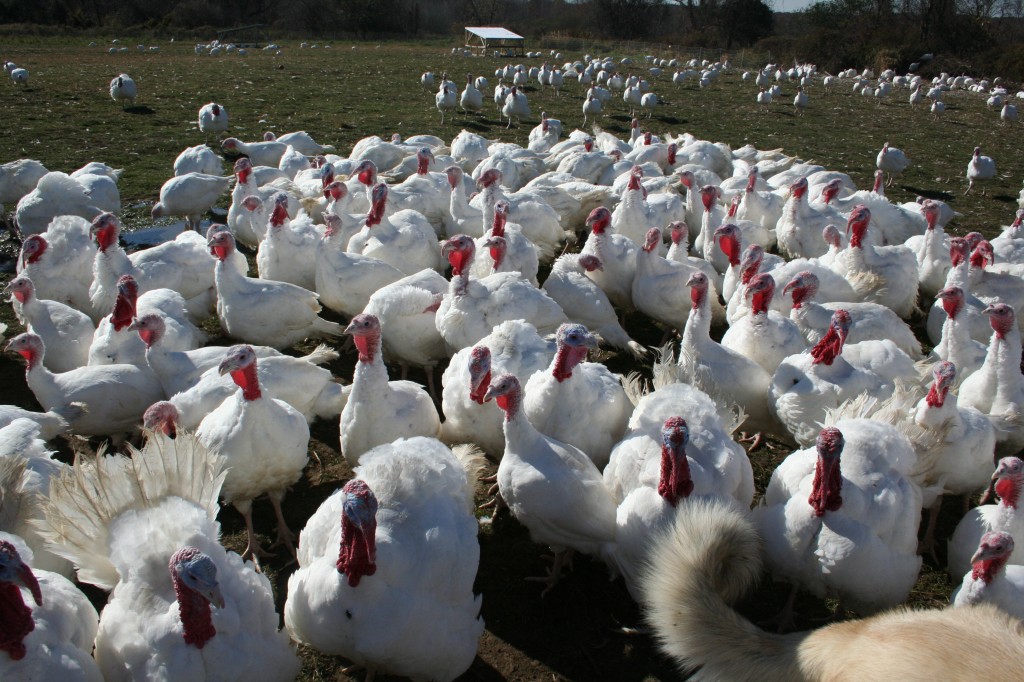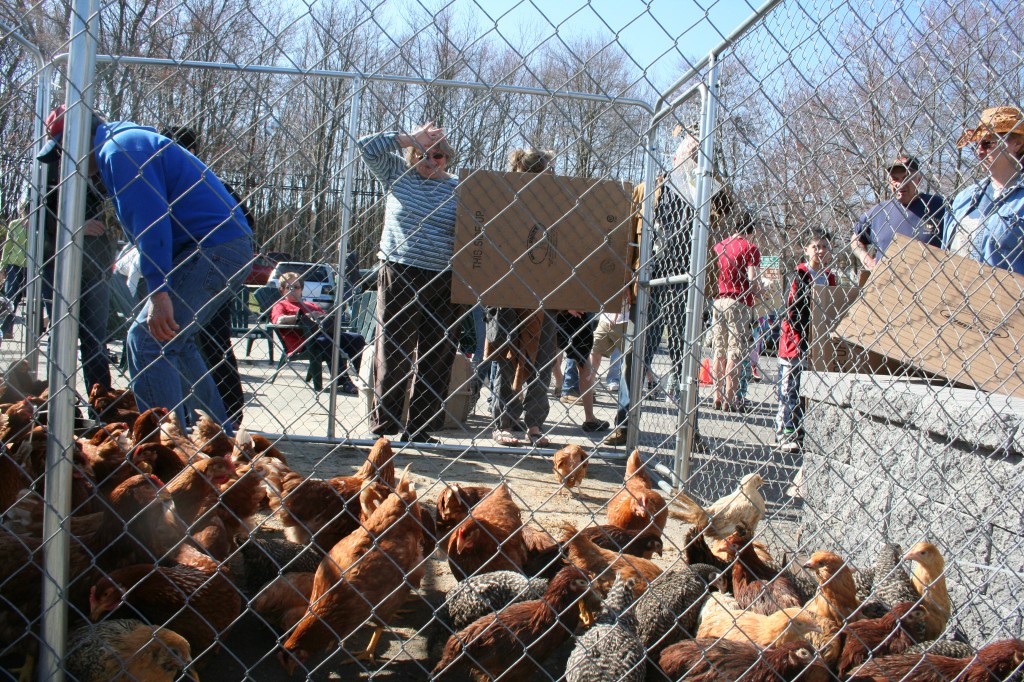New Law: Encourage ‘Farm, Food, Jobs’
 Incredible! You don't see this every day. That's Chris Norige inside the KofKoff Farms of Connecticut (part of Moark LLC's east division) most distinctive display, at the recent all-day Poultry Day/Connecticut Poultry Association meet at the Tolland Agricultural Center. The event featured presentations about the poultry industry, updates, presentations, and made-to-order omelets before the evening's annual meeting.
Incredible! You don't see this every day. That's Chris Norige inside the KofKoff Farms of Connecticut (part of Moark LLC's east division) most distinctive display, at the recent all-day Poultry Day/Connecticut Poultry Association meet at the Tolland Agricultural Center. The event featured presentations about the poultry industry, updates, presentations, and made-to-order omelets before the evening's annual meeting.
Small poultry farmers in Connecticut looking to expand their business and grow jobs will now be able to do so thanks to a new law approved by the General Assembly.
Senate President Donald Williams, Jr. (D-Brooklyn) joined Senator Andrew Maynard (D-Stonington), Senator Edith Prague (D-Norwich), State Rep. Mae Flexer (D-Danielson), owners of the Ekonk Hill Turkey Farm, and Gary Proctor, vice president of the Connecticut Poultry Association, to recently announce the changes.
“Local farmers told us we needed to change the law so they could grow their businesses and help the economy, and we listened,” said Senator Williams. “Connecticut’s agricultural industry provides 20,000 jobs to the local economy, but thanks to the new law, its impact could soon be even larger.”
Public Act 10-103, “An Act Concerning Farms, Food and Jobs,” requires the Department of Agricultural to establish regulations and procedures for state inspections of any poultry producer and any producer that also operates as a poultry processing facility.
Public Act 10-103 also make a number of changes to existing laws governing agriculture in Connecticut, including: Preparation and sale of acidified foods (pickles, hot sauce, salsas) on residential farms under certain conditions; strengthening the Connecticut Milk Promotion Board which develops, coordinates, and implements promotional, research, and other programs designed to promote Connecticut dairy farms and milk consumption; and expanding the definition of a farmer's market so as to encourage their growth.
“Connecticut has a proud farming tradition,” said Senator Maynard, “but like so many other businesses, our farms are struggling. This new law is a great example of how government can support business by being responsive and working cooperatively to remedy a situation that would otherwise have negative impact on farmers and on our state economy.”
“What I appreciate most about vibrant, local agriculture, if you will, is how most revenue generated is plowed right back into the local economy, in terms of wages paid and supplies purchased,” Senator Prague said. “What we’ve done to create jobs in this sector of our economy is a solid investment in the future of our state, with the likely prospect of positive returns on that investment.”
Jon Hermonot, of Ekonk Hill Turkey Farm, said, “The new law benefits consumers that are looking for locally grown poultry. It also creates jobs on farms developing poultry enterprises. By opening up new market opportunities for Connecticut’s farms, they will expand and add to the “viability” of farming in Connecticut. Improved farm viability in Connecticut will create jobs. This new law will allow more locally grown foods to be available to Connecticut’s consumers. It also enhances the demand for farmland which will promote the conservation of Connecticut’s natural resources.”

Gary Proctor, chairman, Connecticut Poultry Association said, “Considering the multiplier effect of direct sales, the economic impact to jobs and the economy would be very significant and the removal of roadblocks to marketing local poultry will give rise to more retail farm stands that can begin offering poultry products.”
Steven Reviczky, executive director, Connecticut Farm Bureau Association, testified in favor of the bill in March when it was being considered by the Environment Committee. He said, “I strongly supports this bill and thinks that it is an exciting measure that seeks to promote the local farms and local jobs, which is needed to boost Connecticut economy.”
Excerpt: “The board shall consist of nine members: (1) One appointed by the majority leader of the Senate, who shall be a Connecticut licensed dairy producer and a member of a dairy cooperative; (2) one appointed by the president pro tempore of the Senate, who shall be a Connecticut licensed milk producer and a member of a dairy cooperative; (3) one appointed by the speaker of the House of Representatives, who shall be an independent Connecticut licensed milk producer; (4) one appointed by the minority leader of the House of Representatives, who shall be a Connecticut licensed milk producer and a member of a dairy cooperative; (5) one appointed by the minority leader of the Senate, who shall be a Connecticut licensed milk producer and a member of a dairy cooperative; (6) one appointed by the majority leader of the House of Representatives, who shall be a member of a state-wide health and nutrition organization promoting consumer interests; (7) the Commissioner of Agriculture, or the commissioner's designee; and (8) the chairpersons of the joint standing committee of the General Assembly having cognizance of matters relating to agriculture, who shall be ex-officio members without the right to vote. The board shall elect a chairperson and a vice-chairperson from among its members. Any person absent from (A) three consecutive meetings of the commission, or (B) fifty per cent of such meetings during any calendar year shall be deemed to have resigned from the board, effective immediately. Vacancies on the board shall be filled by the appointing authority. Members of the board serve without compensation but shall, within the limits of available funds, be reimbursed for expenses necessarily incurred in the performance of their duties. The board shall meet as often as deemed necessary by the chairperson or a majority of the board.
(c) The board shall: (1) Develop, coordinate and implement promotional, research and other programs designed to promote Connecticut dairy farms and milk consumption; and (2) prepare and submit to the joint standing committee of the General Assembly having cognizance of matters relating to agriculture an annual report concerning its activities.
(d) The board may use such funds as may be available from federal, state or other sources and may enter into contracts to carry out the purposes of this section. Any money collected by the board pursuant to the provisions of this section shall not be deemed state funds and shall be deposited pursuant to section 4-33, in a qualified public depository in Connecticut. Such funds shall be expended by the board for expenses incurred in administering the budget recommended by the board.”
Readers can see the entire act linked at www. cga.ct.gov/2010/ACT/PA/2010PA-00103-R00HB-05419-PA.htm.
Before the law was enacted no one within the state’s Department of Agricultural was required to inspect small poultry farms in Connecticut. (Federal inspectors only inspect large farms). As a result, small farmers were forbidden from selling their product on the commercial market, to restaurants, farmers’ markets, etc. Poultry farmers with less than 20,000 birds were limited to selling to individuals.


